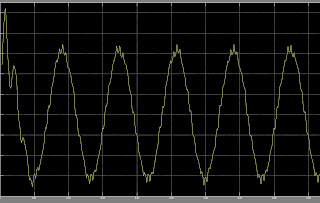After two days of the office time, the more complex part: the connection of the three phase AC circuit, was completed. However, there is a complex problem exist in the DC transfer to three phase AC bridge. If a DC voltage need to be transferred to a AC voltage output, the bridge need a generator to generate a square wave in a certain frequency, but the best frequency of the generator is hard to determined. With the supervisor’s help, we find the best generator frequency and all the components were successfully connected in the circuit by following the figures provided in the lab script. The universal bridge section was made of 6 MOSFET transistor and 6 diode and the best frequency is set to 1080 HZ.
In this week, the whole photovoltaic array simulation model for Matlab-Simulink was successfully completed. However, during the process of getting the results of PV cell, there were some problems with the figure. The graph is appearing slowly in the scope, the curve can not be completely shown in the scope.
In the office time, out supervisor tell us to change the solver section in the simulation configure, and the problem was solved. The following graph shows the complete block diagram of this project:
the complete photovoltaic array circuit
As our group complete this project, the result can be release as follows.
the result of part1
Result(Part 1):
According to the figure, the current through the PV unit is Ic, the voltage output of PV array is Vpv, and the power output of the PV array is Ppv. As shown in the Ic - Vpv figure, the Ic decrease as the voltage Vpv increase because the Ic and Vpv has a relationship of Vc = (A * k * T) / e * ln((Iph + I0 - Ic) / I0) - Rs * Ic. And the Ppv has a maximum value when the voltage output is 16V because ISC = ID−VD / Rp −IPV. Ppv = ISC * ((A * k * T) / e * ln((Iph + I0 - Ic) / I0) - Rs * Ic). As a result, the Ppv has a maximum output 70 when Vpv = 16.
Result(Part 2):
The output voltage of the inverter is shown in the left figure. It was formed by several small square waves. The small square waves are generated by the pulse generator, and the value of the square wave is controlled by the bridge. When the output line voltage is positive, the square waves switch to positive, when the output line voltage is negative, the square wave switch to the negative. After the process of LC circuit, the DC input voltage will be changed into sin AC voltage as a output.
the result of part 2 (the inverter voltage)
the result of part2 (the one phase load voltage)
Result(Part 2):
The output voltage of the inverter is shown in the left figure. It was formed by several small square waves. The small square waves are generated by the pulse generator, and the value of the square wave is controlled by the bridge. When the output line voltage is positive, the square waves switch to positive, when the output line voltage is negative, the square wave switch to the negative. After the process of LC circuit, the DC input voltage will be changed into sin AC voltage as a output.










